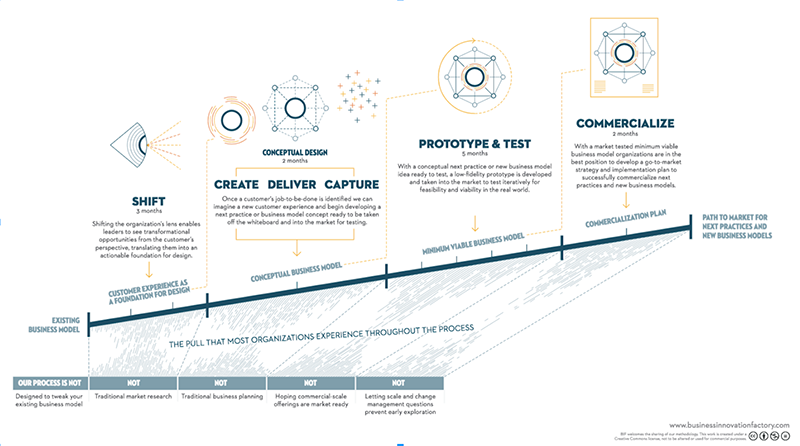Our mission at the Business Innovation Factory (BIF) is to make business model transformation safer and easier to manage. We believe that business model innovation is on the critical path to transforming education, healthcare, and public services, our most important social systems, whose users are not adequately served. Tweaking existing systems won’t be enough. Instead, we imagine, prototype, and test new, more collaborative models with end users in the real world.
Human-centered design is core to our approach. Participative by nature, end users of products and services are at the heart of our design process, and their agency is enabled within it. The approach is both generative and evaluative – meaning we use customer feedback to inspire new ideas and to assess how well ideas are working. Customer input and continual feedback throughout our design phases are key to making it effective. We have codified our approach to business model innovation in our BIF design methodology, a methodology for designing next practices and new business models (the story of how an institution creates, captures, and delivers value):

While our business model design process encourages the participation of the people these models seek to serve from beginning to end, there are three key moments in which feedback plays a critical role in shaping the product of our process– a viable new organizational capability or business model.
- Leveraging ethnographic research to inform designThe first phase of our methodology entails a deep dive into user experience. This includes interviewing, observing, shadowing, and facilitating interactive activities with users to really understand the problem they need solved. In the process, we get to know the humans that our client institutions seek to better serve, understand their hopes, aspirations, and motivations, and elicit their feedback on pain points in their current experience. This critical initial feedback in reaction to existing models and services helps institutional leaders shift their perspective and becomes our foundation for conceptual design.One good example of when feedback played a critical role in explaining the status quo story was in our wor with mothers in Cincinnati. Cincinnati Children’s Hospital hired BIF’s Patient Experience Lab to explore why its community had one of the highest infant mortality rates in the country, when it also had some of the best maternal and infant care in the nation. By exploring the stories, values, and experience of various moms, we learned that a strong racial divide created significant distrust. Distrust of care providers and medical institutions meant mothers from the area were less engaged in their prenatal care, leading to increased rates of preterm births. Once we uncovered this connection, bridging the trust gap quickly became the foundation for engaging women in their prenatal and self-managed care.
- Rapid prototyping and testing to get us better fasterThe outcome of our conceptual design phase, in which we ideate and create concepts for value creation, capture, and delivery, also relies heavily on user feedback for continual improvement. A proposed solution is not a real solution until it is proven in the real world with real customers. A key aspect of our design process is iteration, so we help clients create a prototype and test it with customers– whether citizens, patients, or students. Any feedback they give us on initial models is incorporated into another iteration and tested again. Continual feedback throughout this phase is essential for “failing forward” and getting better faster together. As we test out new practices or models, we cycle through feedback loops repeatedly, which get us closer and closer to an optimal result.In the last two years, in partnership with the Bill and Melinda Gates Foundation, BIF’s Student Experience Lab has designed and prototyped a model to tackle the equity gap in education by building learning communities of Teachers for Equity. The original hypothesis identified the need for more racially relevant curriculum, thinking it would increase student engagement with learning materials. Testing and getting feedback on the prototype, however, revealed that curriculum was only one leg of the challenge. Through those tests we learned that teachers also needed to be conscious of their own racial biases (implicit and explicit), needed the conditions and tools to talk about race, and needed the ability to create more racially conscious norms in the classroom in order to make meaningful progress towards closing equity gaps.
- Community critiques for more expansive solutionsWe believe in working out loud – using customers and the community to help us get better faster. We regularly open our design process up to critique from an even broader group of users and stakeholders. Our community critics represent a wide range of service providers and community members that weigh in on how the new model can or should be improved based on their own experiences. This provides a deeper opportunity for scrutiny and real time iteration.A few years ago, while working with the Health and Wellness Alliance for Children in Collin County, Texas to explore opportunities for community impact, BIF brought together families and social service providers to co-create solutions to community challenges. Through a 2-month long Participatory Design Studio in which they learned and used a design thinking process, local families identified major challenges, explored them from the perspectives of others in their community, brainstormed solutions, and iterated on their ideas. The Participatory Design Studio culminated in a community critique during which the families shared opportunity spaces and strategies they’d formed with their peers, members of the Alliance, and other community stakeholders. During the critique, families received feedback on their work and started a broader conversation on community change with the audience. Ideas and insights developed were then translated into actionable, testable strategies and citizen-designed working groups for the Alliance, providing for better community results.
Human-centered design is customer feedback centric. It requires user feedback for inspiration, iteration, and improvement.
Since human-centered design is core to our business model innovation process, user feedback is also essential to our work with institutional leaders to transform their organizations’ business models. We pride ourselves on designing with and not for customers of our most crucial social systems, and without the type of participation described above, that just wouldn’t be possible. Feedback loops are an integral component to effectively achieve BIF’s mission and complete our critical systems-level work.

Emily McGinnis is the Manager of the Citizen Experience Lab at the Business Innovation Factory (BIF), a role in which she helps grow and engage an actionable network of public service innovators. She is driven by a passion for collaboration, a value for bringing underrepresented voices to the table, and finding new ways to work together for increased impact. Prior to working at BIF, she served four years in the Peace Corps as a Youth Development Facilitator in Peru, supporting both local and national-level programs. Emily graduated from Georgetown University with a BS in Foreign Service and a minor in Latin American Studies.

As Chief Market Maker, Eli MacLaren leads BIF’s real world experience labs- platforms for helping leaders explore and test new business models in healthcare, education, and public service. With over a decade of experience in researching, building, and leading social ventures, Eli is an accomplished social innovator with a deep knowledge of the new platforms required to catalyze and scale social innovation. Eli holds an MS in Strategic Design from New School, Parson’s School of Design and a BA in International Service from American University.







